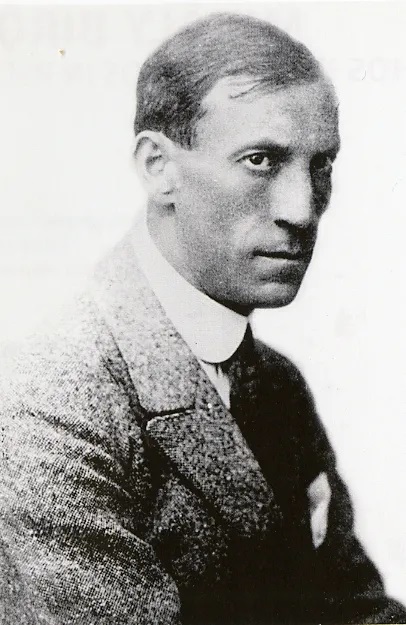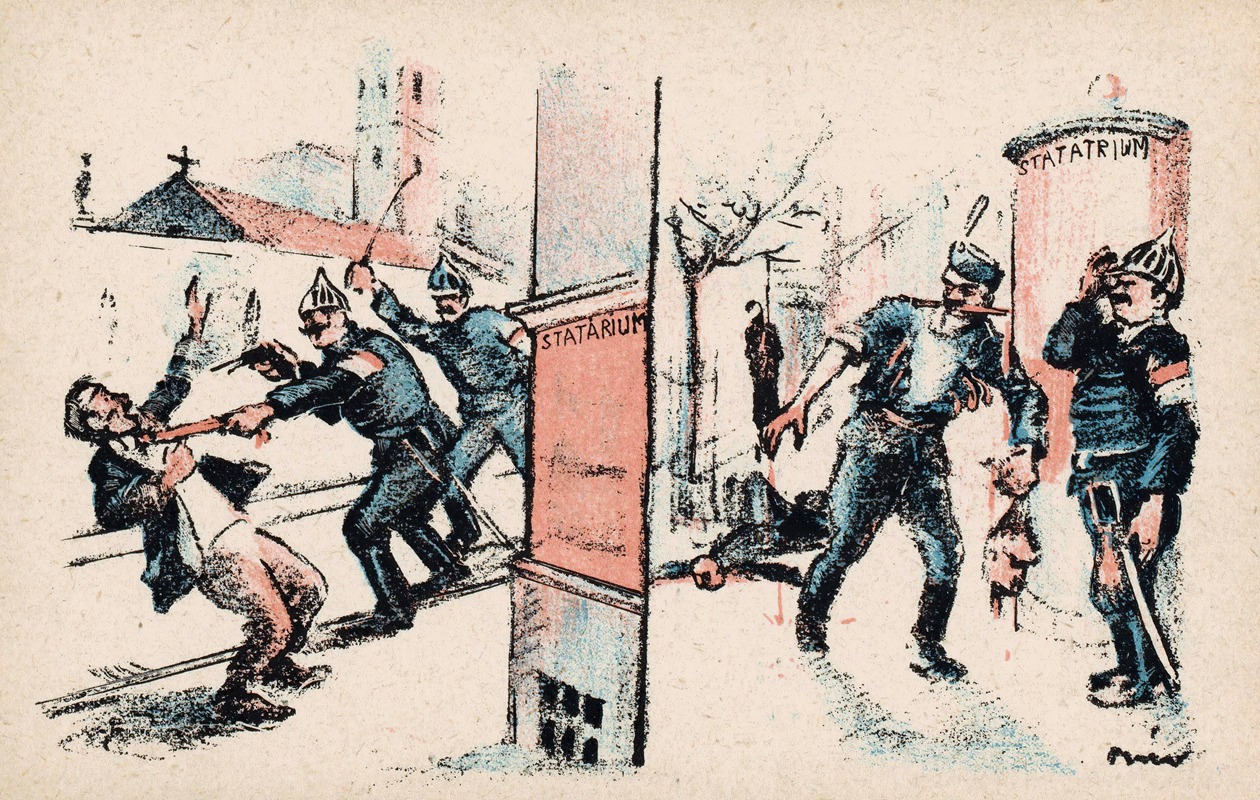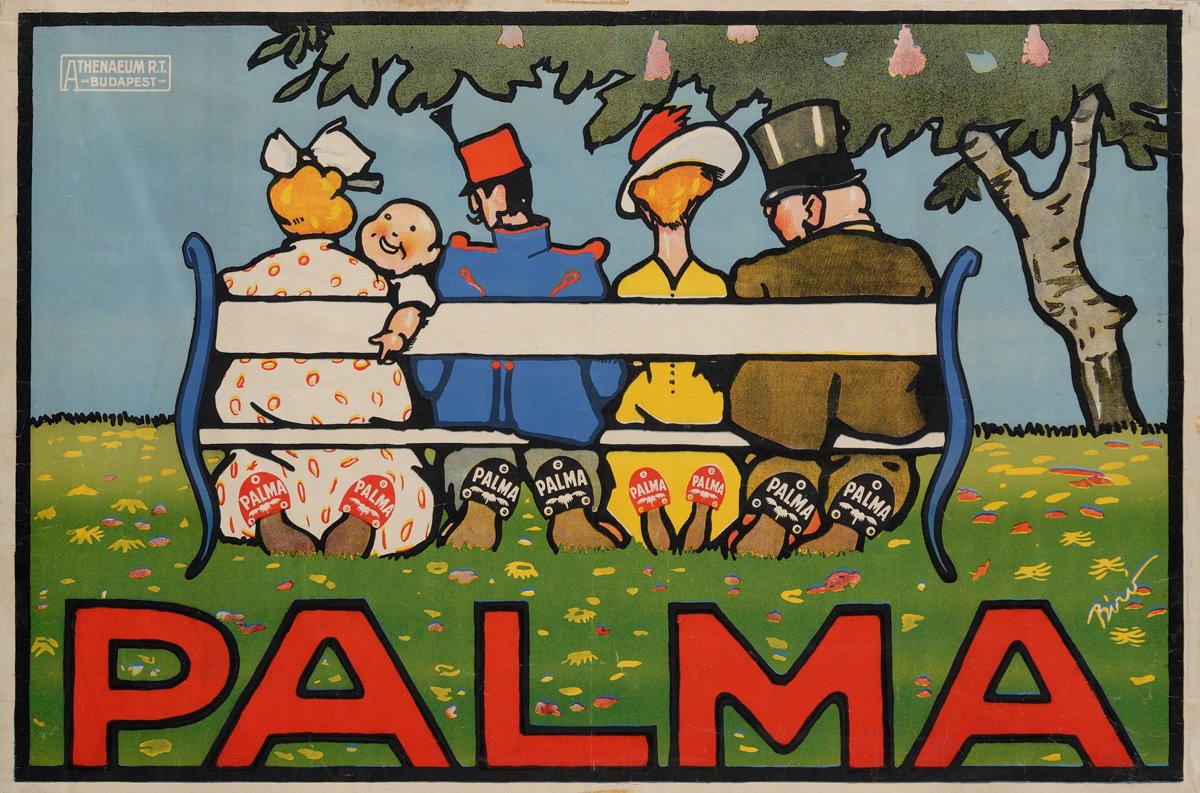Mihály Biró


Mihály Biró was an influential Hungarian artist who, over the first few decades of the 20th century, found success in left-wing politics and commercial art. He was born in 1886 and began studying art in 1903 at the Applied Art School in Budapest.1 In 1908, he decided to continue his studies outside of his native Hungary in Berlin, Brussels, and Munich.2 He then spent ten months in England working for Charles Robert Ashbee’s Guild of Handicraft, which introduced Biró to the Arts and Crafts Movement.3 Upon returning to Budapest in 1910, he joined his half-brother, who was an editor of the left-wing newspaper Népszava, which translates as The People's Word in English.4 Népszava was the official newspaper of the Hungarian Social Democratic Party, which meant that Biró was beginning his professional involvement in politics that would last the rest of his life.5
Biró’s political life in Budapest involved creating propaganda posters. His earliest advocated for election reform and a reduction in military spending.6 He continued creating posters in support of the socialist causes until he received an appointment as commissar for poster propaganda during the short-lived Hungarian Soviet Republic, which formed in March of 1919 and collapsed shortly after in August of that same year.7
After the fall of the Soviet Republic, Biró left Hungary for Vienna and produced The Horthy Portfolio, a print series about the horrors of the counterrevolutionary backlash taking place in Hungary.8 He then moved to Germany and Czechoslovakia and, when Nazi Germany invaded the Sudetenland in 1938, Biró settled in Paris.9 He finally returned to Hungary in 1947, where he took up a teaching position in the newly formed Hungarian People’s Republic, which was a socialist government that formed after WWII, but he died just a year later after a struggle with tuberculosis.10

As difficult as Biró’s years had been after 1919, he still managed to find success as a commercial artist. He worked on film and commercial posters and continued to create political posters for labor organizations.11 It is worth remembering that his success in commercial art went back to his early years in Budapest, when he worked for popular magazines advertising various products like stationary, typewriters, and, most famously, Palma shoes.12 He was such an innovative commercial artist that the German advertising journal Das Plakat referred to him as “a proletarian artist” who had anticipated the relationship between advertising and politics.13 As one commentator put it, “Biró was the first person to make advertising that served both mass politics and mass production.”14
Bibliography
“Biró Mihály.” Biró Mihály | Budapest Poster Gallery. Accessed December 8, 2023. https://budapestposter.com/artists/biro-mihaly.
Communicating Europe: Hungary Manual Information and Contacts on the Hungarian Debate on EU Enlargement. (Budapest and Berlin: European Stability Initative, December 2010), https://www.esiweb.org/pdf/enlargement_debates_manual_hungary.pdf
Heller, Steven. Photograph. PRINT. https://www.printmag.com/daily-heller/hungarys-aggressive-posterist-red-man/.
Mihály Biró, Palma cipősarok, Budapest Poster Gallery, retrieved November 29th, https://budapestposter.com/posters/908.
Mihály Biró, Extreem geweld tegen arbeiders (1920), Artvee, retrieved November 29th, 2023, https://artvee.com/dl/extreem-geweld-tegen-arbeiders#00.
Paterson, Dominic. “Seeing Red: Hungarian Revolutionary Posters: Museum of Modern Art, New York, February 2–August 2, 2011Mihály Biró: Pathos in RotÖsterreichisches Museum Für Angewandte Kunst (MAK), Vienna, October 6, 2010–January 9, 2011.” West 86th: A Journal of Decorative Arts, Design History, and Material Culture 19 (2012): 144. https://www.jstor.org/stable/10.1086/665690.
Simmons, Sherwin. “Mihály Biró’s Népszava Poster and the Emergence of Tendenzkunst.” In Work and the Image, 133–151. 1st ed. United Kingdom: Routledge, 2000.
References
1. Simmons, “Mihály Biró’s Népszava Poster and the Emergence of Tendenzkunst*,” 2019, 134.
2. Simmons, “Mihály Biró’s Népszava Poster and the Emergence of Tendenzkunst*,” 2019, 134.
3. Simmons, “Mihály Biró’s Népszava Poster and the Emergence of Tendenzkunst*,” 2019, 134.
4. Simmons, “Mihály Biró’s Népszava Poster and the Emergence of Tendenzkunst*,” 2019, 134.
5. Communicating Europe: Hungary Manual Information and contacts on the Hungarian debate on EU enlargement, (Budapest and Berlin: European Stability Initative, December 2010), 8.
6. Simmons, “Mihály Biró’s Népszava Poster and the Emergence of Tendenzkunst*,” 2019, 134.
7. Simmons, “Mihály Biró’s Népszava Poster and the Emergence of Tendenzkunst*,” 2019, 141.
8. Dominic Paterson, “Seeing Red: Hungarian Revolutionary Posters: Museum of Modern Art, New York, February 2–August 2, 2011Mihály Biró: Pathos in RotÖsterreichisches Museum Für Angewandte Kunst (MAK), Vienna, October 6, 2010–January 9, 2011,” West 86th: A Journal of Decorative Arts, Design History, and Material Culture 19 (2012): 142, https://www.jstor.org/stable/10.1086/665690.
9. Paterson, “Seeing Red: Hungarian Revolutionary Posters: Museum of Modern Art, New York, February 2–August 2, 2011 Mihály Biró: Pathos in RotÖsterreichisches Museum Für Angewandte Kunst (MAK), Vienna, October 6, 2010–January 9, 2011,” 144.
10. Paterson, “Seeing Red: Hungarian Revolutionary Posters: Museum of Modern Art, New York, February 2–August 2, 2011 Mihály Biró: Pathos in RotÖsterreichisches Museum Für Angewandte Kunst (MAK), Vienna, October 6, 2010–January 9, 2011,” 144.
11. Paterson, “Seeing Red: Hungarian Revolutionary Posters: Museum of Modern Art, New York, February 2–August 2, 2011 Mihály Biró: Pathos in RotÖsterreichisches Museum Für Angewandte Kunst (MAK), Vienna, October 6, 2010–January 9, 2011,” 142.
12. Paterson, “Seeing Red: Hungarian Revolutionary Posters: Museum of Modern Art, New York, February 2–August 2, 2011 Mihály Biró: Pathos in RotÖsterreichisches Museum Für Angewandte Kunst (MAK), Vienna, October 6, 2010–January 9, 2011,” 142.
13. Simmons, “Mihály Biró’s Népszava Poster and the Emergence of Tendenzkunst*,” 2019, 139.
14. Simmons, “Mihály Biró’s Népszava Poster and the Emergence of Tendenzkunst*,” 2019, 140.
15. Steven Heller, Photograph, PRINT, https://www.printmag.com/daily-heller/hungarys-aggressive-posterist-red-man/.
16. Mihály Biró, Extreem geweld tegen arbeiders (1920), Artvee, retrieved November 29th, 2023, https://artvee.com/dl/extreem-geweld-tegen-arbeiders#00
17. Mihály Biró, Palma cipősarok, Budapest Poster Gallery, retrieved November 29th, https://budapestposter.com/posters/908
